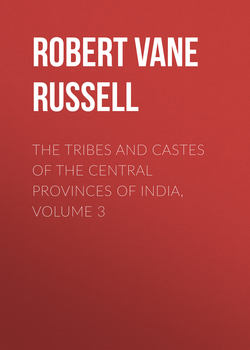Читать книгу The Tribes and Castes of the Central Provinces of India, Volume 3 - Robert Vane Russell - Страница 36
Gond
(c) Marriage Customs
18. The marriage ceremony
ОглавлениеThe most distinctive feature of a Gond marriage is that the procession usually starts from the bride’s house and the wedding is held at that of the bridegroom, in contradistinction to the Hindu practice. It is supposed that this is a survival of the custom of marriage by capture, when the bride was carried off from her own house to the bridegroom’s, and any ceremony which was requisite was necessarily held at the house of the latter. But the Gonds say that since Dūlha Deo, the bridegroom god and one of the commonest village deities, was carried off by a tiger on his way to his wedding, it was decided that in future the bride must go to the bridegroom to be married in order to obviate the recurrence of such a calamity. Any risk incidental to the journey thus falls to the lady. Among the wilder Māria Gonds of Bastar the ritual is very simple. The bride’s party arrive at the bridegroom’s village and occupy some huts made ready for them. His father sends them provisions, including a pig and fowls, and the day passes in feasting. In the evening they go to the bridegroom’s house, and the night is spent in dancing by the couple and the young people of the village. Next morning the bride’s people go back again, and after another meal her parents bring her to the bridegroom’s house and push her inside, asking the boy’s father to take charge of her, and telling her that she now belongs to her husband’s family and must not come back to them alone. The girl cries a little for form’s sake and acquiesces, and the business is over, no proper marriage rite being apparently performed at all. Among the more civilised Mārias the couple are seated for the ceremony side by side under a green shed, and water is poured on them through the shed in imitation of the fertilising action of rain. Some elder of the village places his hands on them and the wedding is over. But Hindu customs are gradually being adopted, and the rubbing of powdered turmeric and water on the bodies of the bride and bridegroom is generally essential to a proper wedding. The following description is given of the Gonds of Kanker. On the day fixed for the marriage the pair, accompanied by the Dosi or caste priest, proceed to a river, in the bed of which two reeds five or six feet high are placed just so far apart that a man can lie down between them, and tied together with a thread at the top. The priest lies down between the reeds, and the bride and bridegroom jump seven times over his body. After the last jump they go a little way off, throw aside their wet clothes, and then run naked to a place where their dry clothes are kept; they put them on and go home without looking back. Among the Gonds in Khairāgarh the pair are placed in two pans of a balance and covered with blankets. The caste priest lifts up the bridegroom’s pan and her female relatives the bride’s, and walk round with them seven times, touching the marriage-post at each time. After this they are taken outside the village without being allowed to see each other. They are placed standing at a little distance with a screen between them, and liquor is spilt on the ground to make a line from one to the other. After a time the bridegroom lifts up the screen, rushes on the bride, gives her a blow on the back and puts the ring on her finger, at the same time making a noise in imitation of the cry of a goat. All the village then indulge in bacchanalian orgies, not sparing their own relations.
